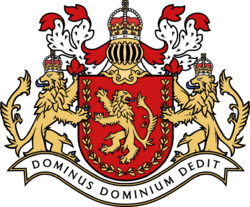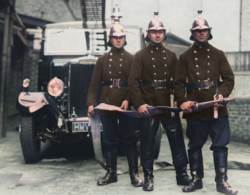Home Service (Great Nortend)
| Home Service | |
|---|---|
 | |
| Active | 8 June 1936 — |
| Country | |
| Role | Civil and military defence |
| Insignia | |
| War Cross | |
| Red Ensign | |
| Blue Ensign | |
His Majesty's Home Service consists of the combined reserve military forces of Great Nortend. The Home Service is divided into three divisions, being the Home Force, the Home Fleet and the Home Flight, serving as the reserve counterpart to the Royal Army and the Navy Royal's Sea Fleets, and Air Flight respectively. It is tasked principally with the defence of the Realm, rather than offensive actions. It also trains to assist the civil forces in responding to civil emergencies such as fires, floods, storms and riots within their areas of expertise.
The Home Service is mainly manned by part-time voluntary home servicemen in civilian occupations who participate in military training and activities on a part-time basis after full-time muster service. Servicemen are obliged to attend weekly parade or drill nights as well as four week-end bivouacs and up to a fortnight of training programmes annually.
Owing to their role as home and civil defence, home servicemen have never been deployed abroad in offensive combatant roles and are thus nicknamed the „Marching Boys”, or the „Boys in Brown” in reference to the brown duty dress tunics worn (compared to the blue undress tunics commonly worn in public by regular and muster servicemen).
History
The Defence of the Realm Act 34 Edm. IX established the modern-day Home Service in 1936 after deficiencies in the existing home defence was raised in the Great Astyrian War. The Act restructured and combined the former locally raised militias, yeomanries, volunteer corps, naval merchant marine and air reserve forces. The resulting two services, the Home Force and Home Fleet, were placed under the command of the War Office.
In 1946, the Act was amended to reform the system of conscription and home service in response to the heavy burden it placed on young workers and their families. In 1960, with the establishment of the Air Flight as a distinct sub-unit of the Navy Royal, a Home Flight was carved out of the Home Fleet as a similar distinct sub-unit for air capability.
Organisation
The Home Force is organised with platoons of around 40 to 60 home servicemen based in local settlements and areas. Platoons are commanded by a lieutenant. A platoon is divided into 3 or 4 sections led by corporals and lancepersades. Most activities are conducted either as a section or as a platoon. Several platoons of the Home Force within a hundred are grouped together as a company, and often undertake exercises together. A company is commanded by a captain, assisted by a junior ensign. Several companies form a district, commanded by a major. Several districts form a militia battalion, which is a county-sized formation commanded by a lieutenant-colonel.
The Home Fleet and Flight are structured similarly, albeit built around the company structure rather than on platoons.
Duties
The Home Service shifted its focus after the 2007 Whenton Report back to its original principles of local military and civil defence after a slow decline in standards leading to some platoons even regularly leaving rifles at home. Since 2008, Home Service companies have participated in regular major exercises domestically and abroad. Furthermore, they retain their on-going responsibility for the defence of critical local infrastructure such as water works, gas plants and electricity mills, as well as response in emergency scenarios such as fire, severe flooding, snowfall, storms, riot or invasion.
Currently, servicemen are required to attend weekly parade nights where they participate in military and civil training. They also participate at least four week-end bivouacs annually and up to a fortnight of training at a military installation. Training and exercises are undertaken in sections, platoons and companies, depending on the exigencies of the situation. In addition to the fixed training service, there is also active service in times when the Home Service is called into action. In these circumstances, servicemen have additional duties.
Military
As a military defence force, the Home Service have the duty of protecting local populations and critical infrastructure in the event of enemy attack. The maintainance of air-raid, nuclear fall-out and bio/chemical weapon shelters is usually delegated to the Home Service by local authorities. Food, water and supplies for up to four weeks, or two months on ration, must be kept in each shelter to provide sufficient shelter for up to 25 million people.
The Home Service also check and maintain emergency sirens installed throughout the country at each shelter, which provide an audible guide as to where shelter is available. There are regular tests of the emergency sirens. Every few years, they run local drills of the emergency sirens for an attack where people are timed as to how quickly they are able to reach the local shelter. Specific siren „codes” are also used to call servicemen to respond to fires and other civil emergencies.
Civil
The Home Service are often the first responders to civil emergencies such as fire, flooding and storms owing to their number and presence in nearly every community. As such, servicemen are trained to use and operate hydrants and fire engines when professional firemen have yet to arrive. In large areas of the countryside, there are no professional firemen and the Home Service provide the only fire service. In such cases they are provided with fire engines and trained in fighting fires.
The Home Service are also trained to assist the constabulary in emergencies such as flooding, „active shooter” scenarios, riots, &c. All servicemen are trained to perform first aid, and in many areas, may provide the only emergency ambulance transport to hospital. Their intimate knowledge of the local landscape, and where relevant, sea and air capabilities, mean they often assist with search-and-rescue operations.
Manpower
Home Service units have a wide mix of ages, from young men fresh out of muster service to retired regular troops. After compulsory muster service, men may voluntarily choose to serve in the Home Service. Those exempt from muster may also voluntarily join the Home Service.
Home servicemen normally wear duty, deck,field or working dress at on service. Unlike active troops, home servicemen do not wear their uniform when “walking out”. Additionally, uniforms have shoulder patches with the words, „Home Service”. Uniforms additionally have troop, company and battalion patches where applicable.
Home servicemen are not paid for their service, except to cover costs and sometimes, for lost wages when on exercises.
Requirements
A person is required to fulfil the following criteria to be eligible to join the Home Service :—
- Full Erbonian subjectship.
- Between 18 and 35.
- Of sound and sobre character.
- Physically able.
- Military disposition.
There is no maximum age limit for service; however, a home serviceman will be forced to retire or leave if he fails to maintain sufficient physical ability to service in the Home Service. A home serviceman must also be able to fulfil his obligations to the Home Service.
See also
This page is written in Erbonian English, which has its own spelling conventions (colour, travelled, centre, realise, instal, sobre, shew, artefact), and some terms that are used in it may be different or absent from other varieties of English. |





